The Early Series coinage
by Cori Sedwick Downing
Relative Dating for Early Series Coins (Assayers R, P, F and G)
We can make some broad assumptions of dating of Early Series coins based on die study work by Kent Ponterio who was able to determine the order of tenure of assayers at the Mexico City mint. Kent was able to show an overlap of coin design from one assayer to the next. We can also see this with overassayer coins, which Nesmith never saw or he might have ordered the Early Series assayers differently. These are Assayer P/R , Assayer F/P and Assayer G/F.
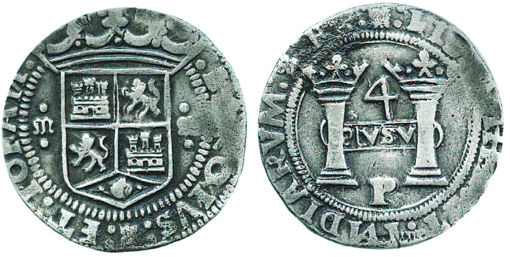
Early Series Assayer P over erased R 4 reales (Sedwick auction #12, Oct 2012, lot 892)
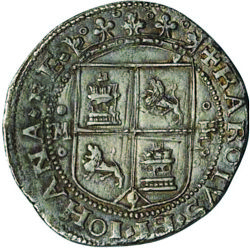
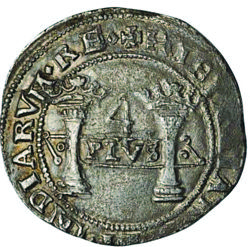
Early Series Assayer F over P 4 reales (Ponterio auction #150, Aug 2009, lot 9100)
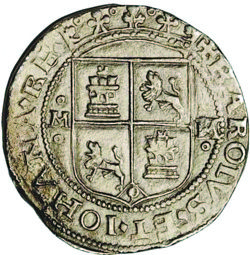
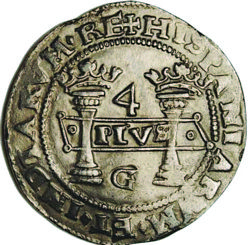
Early Series Assayer G over F 4 reales (Ponterio auction #150, Aug 2009, lot 9101)
Another way to give some relative dating to Early Series coins, at least Assayer P coins, is by distinguishing his earlier issues from his later ones. Earlier coins used lettering in the legends similar to his predecessor, Assayer R, so coins bearing HISPANIE were minted before coins bearing HISPANIARVM
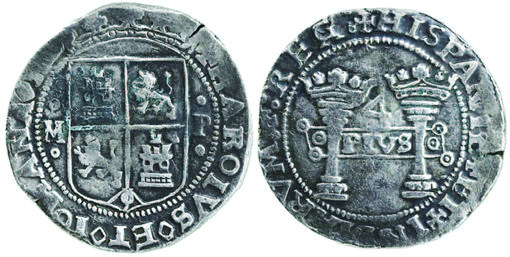
Early Series Assayer P 4 reales HISPANIE (Sedwick auction #15, May 2014, lot 252)
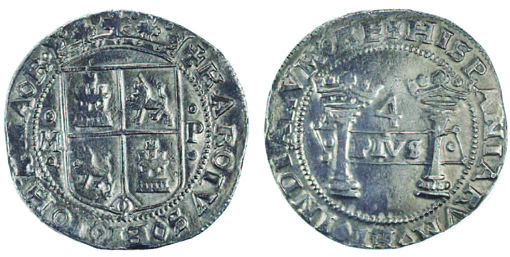
Early Series Assayer P 4 reales HISPANIARUM (Sedwick auction #18, October 2015, lot 498)
Francisco del Rincón (Assayer R), 1536-1538
The first assayer of the Mexico City mint, Assayer R, oversaw the minting of coins of ¼, ½, 1, 2, 3, 4, and 8 reales, although not all at the same time. Initially the mint created ¼, ½, 1, 2, and 3 reales, but the 3 reales was unpopular due to its similarity to the 2 reales and was discontinued sometime in late 1537 to early 1538 and replaced with 4-reales coins. The extremely rare 8-reales coins—of which there are only three known—were produced at the same time as the 4 reales but proved too difficult to make. The fractional denominations are also extremely rare. Based on analysis of the lettering in the legends, the first emissions from the mint were probably ¼, ½, 1 and 3 reales, with the 2-reales coins appearing a little later. Punches with Gothic lettering used to create the legends on both sides of the coins broke often and were replaced as needed by crude punches of local creation or Latinized punches. Between the words of the legends were inserted devices known as “stops,” which were limited to two rondules (like a fat colon), a cross potent , and/or a three-part creation which Nesmith described as a “number 9 punch,” sometimes rotated 180 degrees. Later assayers became more creative with the stops.
The shield-side legend read KAROLVS ET IOHANA (the IOHANA often abbreviated), sometimes with a D at the end for DEI GRATIA (“by the Grace of God”). Some of the 3-reales coins bear a longer ending of DEIGRA or DEIGRA R (the R standing for REGES, or rulers). These 3-reales coins also illustrate an experiment in crown placement, as a very few show the crown entirely within the beaded circle that divides the legend from the interior design. In all denominations, the lion in the shield, representing León, sometimes sported a crown and a tongue. On either side of the shield was a Gothic M, representing the Mexico City mintmark.
One hallmark of Assayer R was the use of a rounded panel containing an abbreviated form of PLVS VLTRA placed between the Pillars of Hercules on the pillars side (some early Assayer-P and P/R coins show this type of panel as well). For unknown reasons, this style was supplanted by a right-leaning rhomboid panel at the time of the first emission of 4 and 8 reales coins. The abbreviation within the panel was longer at first, then shortened to PLVS, a convention which persisted throughout the rest of the Early Series. The assayer’s initial R, appearing between the bases of the pillars, was at first Gothic and later Latin, as the letter-punches deteriorated. The legend on the pillars side read HISPANIE ET INDIARVM followed sometimes by REGES (only on the 3-reales variety with waves beneath the pillars), RE, or R.
Main type of 1-real coins:
• Various abbreviations for PLVS VLTRA inside rounded banner between pillars with Gothic R between bases of pillars
Main type of 2-reales coins:
• Various abbreviations for PLVS VLTRA inside rounded banner between pillars with either Gothic or Latin R between bases of pillars
Main types of 3-reales coins:
• Waves beneath pillars, PLVSVL inside rounded banner between pillars, Gothic R between bases of pillars, and 3 dots for denomination
• Without waves beneath pillars, PLVSVLT inside rounded banner between pillars, Gothic R between bases of pillars, and 3 dots for denomination
• Without waves beneath pillars, PLVSVL inside rounded banner between pillars, Gothic R between bases of pillars, and 3 connected vertical bars for denomination
Main types of 4-reales coins:
• Various abbreviations for PLVS VLTRA (PLVSVLT, PLVSVL, PLVSVT, LVSV) inside rounded banner with either Gothic or Latin R between bases of pillars
• PLVSV inside rounded banner with Latin R between bases of pillars
• PLVS inside rounded banner with Latin R between bases of pillars
• PLVS inside right-leaning rhomboid banner with Latin R between bases of pillars
For Early Series Assayer R I have catalogued
| No of coins |
No. of varieties |
||
| 1 real | 50 | 15 | |
| 2 reales | 25 | 18 | |
| 3 reales | - waves below pillars and three dots | 5 | 3 |
| - no waves below pillars and three dots | 40 | 10 | |
| 4 reales | about 118 | 47 |
There are 53 3-reales coins listed from the Ines de Soto.
8-reales coins
The Golden Fleece shipwreck, sunk around 1550, contained three 8-reales coins, the only ones known.
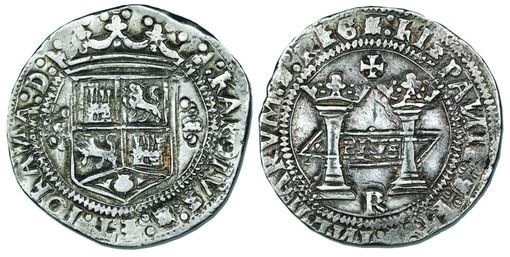
Early Series Assayer R 8 Reales (Sedwick auction #16, Nov 2014, lot 404)
Sold for $587,500
Oddball coins
The following are some oddball coins that are extremely rare:
NIDIARVM
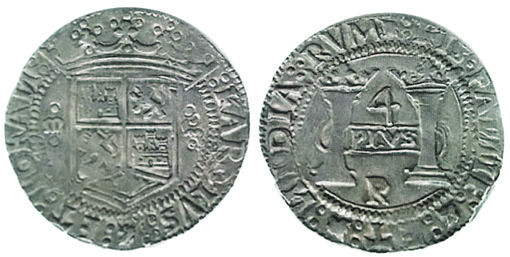
NIDIARVM Error on Early Series Assayer R 4 reales
(Sedwick auction #1, May 2007, lot 349)
Waves below pillars on 3 reales
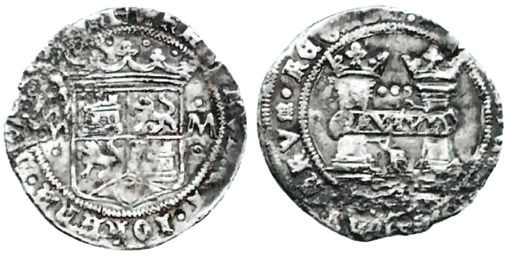
Wave below Pillars on Early Series Assayer R 3 reales
(Sedwick auction #4, Nov 2008, lot 195)
Pedro de Espina (Assayer P), 1538-1541
(For more detailed analysis of the coins of Assayer P, see here).
The denominations of coins minted under Assayer P were ¼, ½, 1, 2, and 4 reales, and ¼-real coins are almost non-existent, the Nesmith #22 Plate Coin being the only one known. The first emissions used re-worked dies from Assayer R’s tenure. There are examples of both the rounded-banner variety and the right-leaning rhomboid banner variety (P/R is known in both varieties in 4 reales). The left-leaning rhomboid banner variety was a later convention coinciding with a permanent switch from a Gothic P to a Latin P for the assayer-mark.
Initially the coins looked very similar to Assayer-R coins, with the P replacing the R between the base of the Pillars of Hercules on the pillar side and a Gothic M on either side of the shield (Nesmith did not know of the existence of this type). However, most of the coins minted under Assayer P—and these coins are the most common of the Early Series—bore a new design with the P moved from the pillars side to the shield side of the coin, to the right (common) or left (rare) of the shield, and the M mintmark on the opposite side of the shield, thus leaving a blank space between the bases of the pillars on the other side of the coin.
All lettering in the legends on both sides of the coin was Latin, with the exception of the few holdovers from Assayer R that bore a Gothic M mintmark on either side of the shield. Assayer P displayed a flare for the dramatic with his creative use of devices as stops. He embellished upon Assayer R’s use of double rondules as stops by adding lozenges, cross potents, quatrefoils, mascles, and rondules-in-annulets, sometimes in combination. The banner on the pillars side displayed embellishment not seen during Assayer R’s tenure, with the use of annulets and rondules-in-annulets both within the banner and at its corners.
The legend on the shield side, which became the standard for future Early Series coins, typically read: KAROLVS ET IOHANA, with R or RE appended after a stop. IOHANA could be abbreviated to IOHA and IOHAN, or even IOAN and IOANA. As noted above, mintmark M and assayer-mark P were placed to the left or the right of the shield opposite each other, with either annulets or rondulesin-annulets above and below the M and P (hence, for example, “oMo-oPo”).
The legend on the pillars side, which also became the standard for future Early Series coins, typically read HISPANIARVM ET INDIARVM, with many abbreviations such as HISPANIE and INDIAR. Sometimes RE followed. As noted above, the P was moved from between the bases of the pillars to the shield side of the coin. The left-leaning rhomboid banner predominated.
Main types of ½ real coins:
• Latin P-M flanking KI and left-leaning rhomboid banner between pillars
• Latin M-P flanking KI and right-leaning rhomboid banner between pillars
• Latin M-P flanking KI and left-leaning rhomboid banner between pillars
Main types of 1-real coins:
• Latin P-M flanking shield and left-leaning rhomboid banner between pillars
• Latin M-P flanking shield and right-leaning rhomboid banner between pillars
• Latin M-P flanking shield and a left-leaning rhomboid banner between pillars
Main types of 2-reales coins:
• Latin P-M flanking shield and right-leaning rhomboid banner between pillars
• Latin M-P flanking shield and right-leaning rhomboid banner between pillars
• Latin M-P flanking shield and left-leaning rhomboid banner between pillars
Main types of 4-reales coins:
• Gothic M on both sides of shield and Latin P between bases of pillars
• Latin P-M flanking shield and right-leaning rhomboid banner between pillars
• Latin P-M flanking shield and left-leaning rhomboid banner between pillars
• Latin M-P flanking shield and right-leaning rhomboid banner between pillars
• Latin M-P flanking shield and left-leaning rhomboid banner between pillars
Assayer P has some rarities in all denominations that have to do with the placement of the mintmark and assayer on the obverse (is it P-M or M-P?) and whether there is a right- or left-leaning rhomboid panel on the reverse of the coin (for a table of numbers and varieties, see here). Obviously P-M is rarer than M-P regardless of which type of banner is on the reverse and as a matter of fact, Nesmith had never even seen a 4 reales P-M coin.
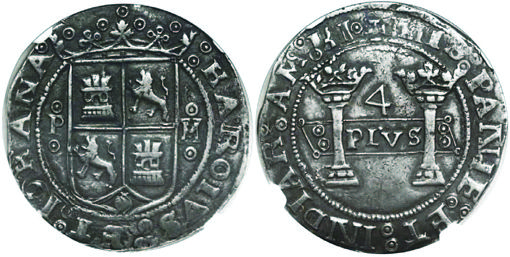
P-M on Early Series Assayer P 4 reales (lSedwick auction #20, November 2016, lot 561)
Francisco de Loaiza (Assayer F), 1541(?)
The rarest Early Series coins were minted under the brief tenure of Assayer F in denominations of ½, 1, 2, and 4 reales. There may have been ¼-real coins minted as well, but to date none are known (Nesmith could not cite any examples either). F/P is known in the ½, 2, and 4 reales. All coins are of the left-leaning banner variety and most feature lozengesas stops between words in the legends, as they were probably all re-worked dies from Assayer P. There are approximately 26 coins known in collections and auctions, with the majority from the “Golden Fleece wreck”This wreck, sunk ca. 1550 in the northern Caribbean, was nicknamed for a royal stamping (“Golden Fleece”) on several of the gold “finger” bars (ingots) it yielded. Practically all the coins from this wreck were Mexican Carlos and Joanna silver coins (all assayers prior to S), including several rarities, the most important being three specimens of the Rincón “Early Series” 8 reales of 1538, the very first 8 reales ever struck in the New World. To date the finders of the wreck have not identified the wreck or disclosed its exact location, but they affirm it was in international waters in the northern Caribbean. Though it was a relatively small find of a few thousand coins at most, it has been the primary source for Mexican Carlos and Joanna coins on the market since the mid-1990s.
Perhaps more impressive than the coins from this wreck are the few dozen gold and silver ingots it has yielded, all of which have entered the market exclusively through Daniel Frank Sedwick. The varying purities of these bars are reminiscent of the “tumbaga” bars, although the later gold ingots were cast in somewhat standard shapes (“fingers”) and sizes. The silver ingots from this wreck, popularly known as “splashes,” were simply poured onto the ground, leaving a round, flat mound of silver that was subsequently stamped with a tax stamp in the form of a crowned C for King Charles I and/or a fineness in the usual block Roman numerals in parts per 2400, much like the karat system we use today. The gold ingots also show a fineness marking, but no tax stamps or other markings, in parts per 24, with a dot being a quarter karat. Many of the silver and gold ingots from this wreck were cut into two or more parts, presumably to divide into separate accounts., one from the “Ines de Soto wreck” (ca. 1557), and none from the Spanish 1554 Fleet (Padre Island)The 1554 Fleet consisted of four caravels, the San Andrés, the Santa María de Yciar, the San Esteban, and the Espíritu Santo, all but the first of which foundered off what is now Padre Island in a violent storm. There were many survivors, but natives killed nearly all of them. Much of the treasure was salvaged soon afterward by the Spanish but, according to Spanish records, most of the shipment did not make it back to Spain, and in fact some of it was later lost off the east coast of Florida. There is also evidence that at least part of the specie cargo went from Havana to Puerto Rico and was possibly lost in another wreck in that vicinity. In the 1960s two of the ships were rediscovered and salvaged by an out-of-state company, causing controversy by removing what Texans thought should belong to their state. (The third wreck-site was apparently obliterated by a dredging operation in the late 1940s on what is known as the Mansfield Cut, a manmade inlet.) Texas conducted its own excavations on the two sites in the 1970s. The 1554 Fleet wrecks have yielded almost exclusively Mexican coinage of Carlos and Joanna (up to and including assayer S), some of which still washes up on the beaches of Padre Island. Even when found on the beach, these coins are illegal to own in Texas, which has declared them all to be the property of the State, but they do trade freely elsewhere. Uncleaned specimens (mostly beach finds) are distinctively rusty in colour and therefore are usually distinguishable from coins from the “Golden Fleece wreck”,.
Main type of ½-real coins:
• Latin M-F (or M-F/P) flanking KI and left-leaning rhomboid banner between pillars
Main type of 1-real coins:
• Latin M-F flanking shield and left-leaning rhomboid banner between pillars
Main type of 2-reales coins:
• Latin M-F (or M-F/P) flanking shield and left-leaning rhomboid banner between pillars
Main type of 4-reales coins:
• Latin M-F (or M-F/P) flanking shield and left-leaning rhomboid banner between pillars
Juan Gutiérrez (Assayer G), 1541(?)-1542
This assayer struck coins in the denominations of ¼, ½, 1, 2, and 4 reales (although Nesmith did not know of any ¼-real specimens), but also began copper coins in the denominations of 2 and 4 maravedís in 1542. Assayer G’s tenure carried over to the new Late Series coinage starting in the same year. For unknown reasons, the assayer’s initial G reverted to the position between the bases of the pillars, as was the convention under Assayer R (and the earliest Assayer P). This was probably why Nesmith surmised his tenure followed that of Assayer R (especially since Nesmith did not know of the existence of early Assayer-P coins with P between the bases of the pillars), although die studies have disproven that theory. The over-punchings M/F and M/F/P are known in 1 and 4 reales. As an interesting side note, Nesmith #11, a 4 reales coin with a left-leaning rhomboid banner and lozenges for stops, is the most common single-variety Early Series coin with about two dozen examples known.
With the assayer’s mark G now placed on the pillars side of the coin, the mintmark M returned to the shield side and was placed on either side of the shield with an annulet above and below (oMo-oMo). As with Assayer P (and the short-lived Assayer F), devices such as rondules, annulets, lozenges, cross potents, quatrefoils, double rondules, and double rondules-in-annulets vertically, were used as stops separating letters in the legends, with lozenges being a clear favorite. On the pillars side, the left-leaning rhomboid banner predominated; however, there are several examples of ½- and 2-reales coins with a right-leaning rhomboid banner, harkening back to Assayer-P coinage. PLVS inside the banner was the norm, although there are a few examples of ½- and 2-reales coins bearing PLV instead. Devices used as stops between letters in the legend on the pillars side were limited to lozenges, cross potents, and quatrefoils with lozenges the most common. The banner was always punctuated with a single annulet in each corner and single annulets outside the pillars. In other words, there are far fewer varieties under Assayer G than Assayer P.
Main types of ½-real coins:
• Latin M-M flanking KI and left-leaning rhomboid banner between pillars
• Latin M-M flanking KI and right-leaning rhomboid banner between pillars
Main type of 1-real coins:
• Latin M-M flanking shield and left-leaning rhomboid banner between pillars
Main types of 2-reales coins:
• Latin M-M flanking shield and left-leaning rhomboid banner between pillars
• Latin M-M flanking shield and right-leaning rhomboid banner between pillars
Main type of 4-reales coins:
• Latin M-M flanking shield and left-leaning rhomboid banner between pillars
Oddball coins
The following are some oddball coins that are extremely rare:
Transposed lions and castles on early Assayer G 1 real
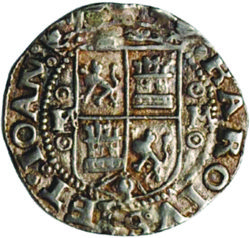
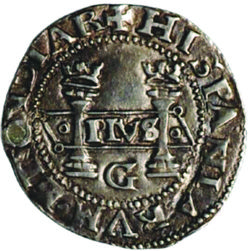
Transposed Lions and Castles on Early Series Assayer G 1 real
(Ponterio auction #150, Aug 2009, lot 9086)
Discoveries Since NesmithRobert I. Nesmith, The Coinage of the First Mint of the Americas at Mexico City, 1536-1572 (New York: The American Numismatic Society, 1955), 49-50 (available in the USMexNA online library)
1. Eight-reales coins did exist (three known and all from the “Golden Fleece wreck” of ca. 1550) and from their characteristics can be attributed to being minted late in Assayer R’s tenure.
2. There are many more examples of 3 reales than previously thought (at least 5 examples of coins with waves and 34 without waves).
3. Under Assayer R there are examples of 2 reales coins with a banner motto between pillars longer than just PLVS and 4 reales coins with a banner motto longer than PLVS or PLVSV.
4. The ¼, ½, 1, and 3 reales may have been minted before 2-reales coins, based on an analysis of the lettering in the legends.
5. The banner is depicted as a ribbon which flows high to low in both directions. At this point, it is impossible to determine whether one direction predated another.
6. The correct order of assayers is R, P, F, G. (Nesmith probably thought G came after R because G reverted to putting the assayer mark between the bases of the pillars. Nesmith didn’t know of early Assayer-P coins with P between the bases of the pillars.)
7. Only under Assayer R did lions have tongues and crowns in the shield.
8. The most common 2 and 4 reales die types from Assayer P to Assayer G were as follows:
a. Shield side
i. M-P (or F or G)
ii. Lozenges as stops in the legends
b. Pillars side
i. Left-leaning rhomboid banner
ii. Single annulet in the left and right side of the inside of the banner
iii. Annulets in the corners of the banner
iv. Lozenges as stops in the legend
9. The P-M coins of Assayer P are not “the rarest of all the coins of the Charles and Joanna Early Series” as Nesmith stated with the exception of the ¼ real. Pieces of 4 reales are known in both the right-leaning and left-leaning rhomboid banner varieties.
10. Assayer P’s tenure was not short-lived.
11. Nesmith didn’t question why Assayer G went back to using a right-leaning rhomboid banner, and there is still no answer. It’s curious that the convention is only found on ½ and 2 reales.
12. Nesmith didn’t know about coins recovered from shipwrecks such as the “Golden Fleece wreck” (ca. 1550), Spanish 1554 Fleet (Padre Island), an unidentified wreck off Santo Domingo (ca. 1554), the Santiago wreck off Mozambique (1585)The Santiago sank in 1585 at night on a reef on the Bassas da India atoll betweenMozambique and Madagascar, due to pilot error, following which the captain and crew absconded with the one useable lifeboat, leaving some 400 or more passengers to perish on the wreck. The Santiago was found again and salvaged in the late 1970s by Ernest Erich Klaar and eventually yielded thousands of silver cobs (marketed in the 1980s) of both Spain and Spanish America (particularly the mints of Seville and Mexico). , an unidentified wreck off Cape Canaveral (mid-1550s), and the “Ines de Soto wreck” off Cuba (ca. 1557). The “Golden Fleece wreck” in particular has yielded a trove of Early Series coins, particularly the 4 reales.
